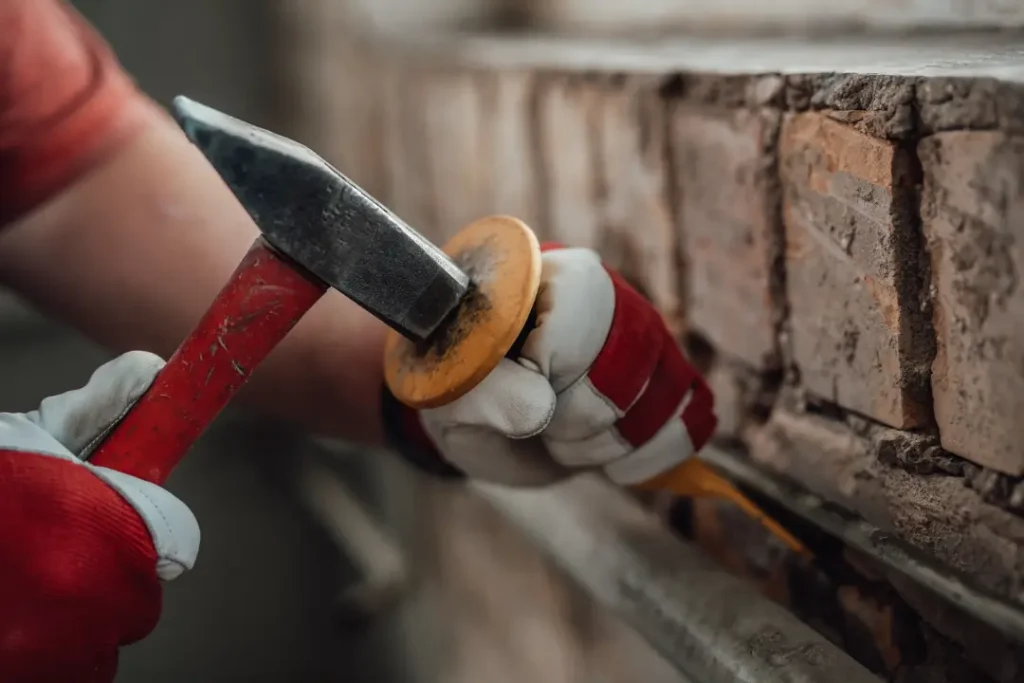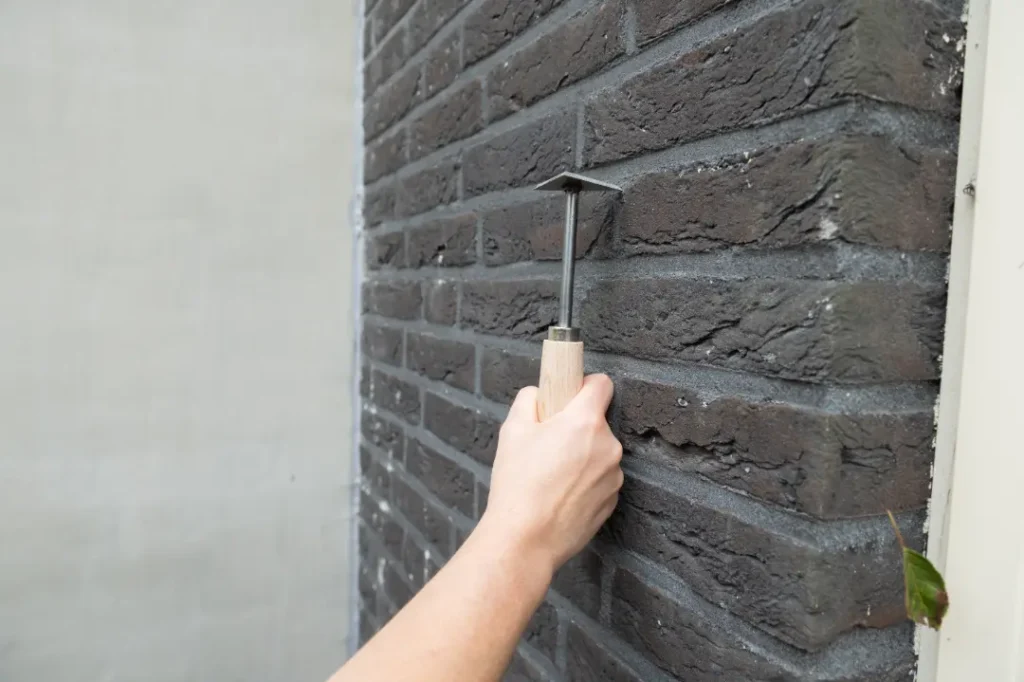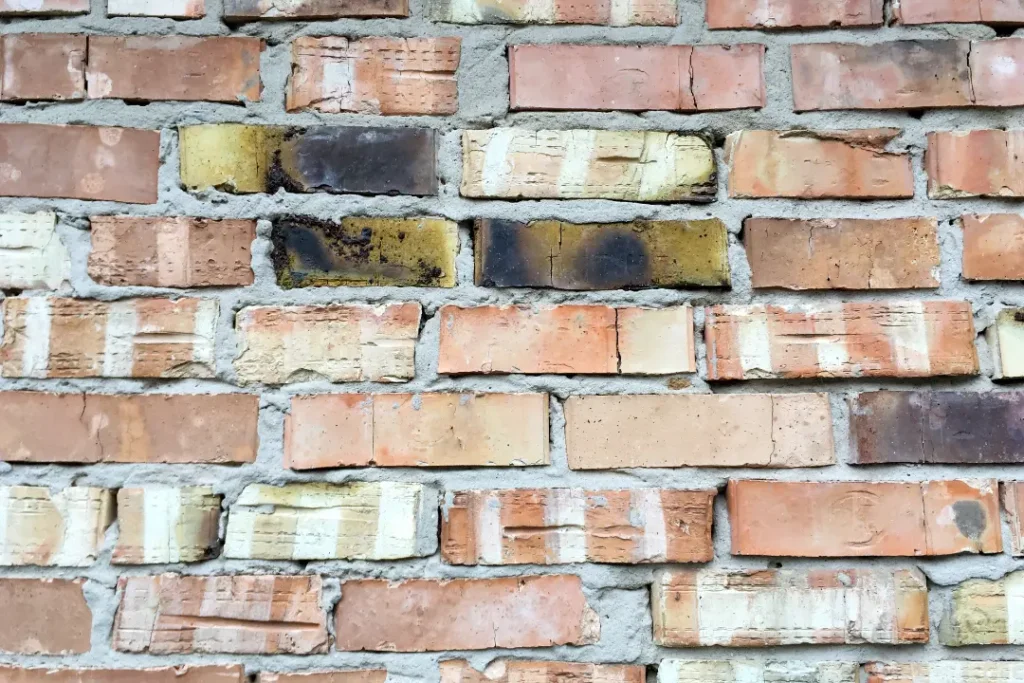Generally, repointing a house every 40+ years is recommended, but this can vary with weather conditions and building age.
In this post, we will explain what repointing is, how to identify if your home needs it, and the benefits of doing it right.
Key Takeaways
- Repointing is essential for maintaining the structural integrity and aesthetic of brickwork, as it addresses mortar joint deterioration caused by weather and aging.
- Regular inspections and repointing every 40+ years are recommended to prevent significant damage, with signs like cracks and damp patches indicating the need for immediate attention.
- While DIY repointing is feasible for minor repairs, professional services are recommended for extensive work to ensure quality and longevity, ultimately saving costs on future repairs.
What is Repointing?
Repointing maintains mortar joints in brickwork, which is crucial for both structural integrity and aesthetic appeal. This process involves replacing old, damaged mortar with new mortar for enhanced brickwork stability and durability.
Over time, factors like age, weather, and wear cause mortar deterioration, leading to weakened joints between bricks and potential water damage.
Properly executed repointing enhances the building’s appearance and significantly boosts its resistance to water infiltration, as effective water regulation in masonry walls depends on the condition of mortar joints.
Poorly executed repointing, on the other hand, can be detrimental and lead to potentially irreparable damage. Additionally, using the correct materials and techniques is vital for preserving brickwork integrity.
Frequency of Repointing Your House
The frequency of repointing your house depends on several factors. Although the lifespan of mortar typically lasts around 40+ years, certain weather conditions like harsh weather, salt spray, and high altitudes can accelerate its deterioration.
As a homeowner in the UK, you should repoint your brick walls every 40+ years to maintain structural integrity. However, periodic inspections are still essential to identify early signs of damage, such as cracks or crumbling mortar.
The age of the building, construction quality, and environmental conditions all influence repointing frequency.
Vigilance in addressing issues promptly helps avoid extensive, costly repairs, ensuring your brickwork remains functional and attractive for years.

Signs That Indicate Your House Needs Repointing
Visible damage to the bricks indicates that the mortar between the bricks is no longer supportive and needs immediate attention.
Recognising signs that your house needs repointing can prevent significant structural damage and costly repairs.
The signs to look out for include:
- Cracks in the bricks
- Softness of the bricks
- Loose bricks falling out
- Gaps in the mortar
- Visible holes in the bricks
- Serious damage to the stones falling out
- Damp patches on walls, especially in lower areas, suggest water ingress through deteriorated mortar joints, particularly in harsh weather conditions like rain.
- Moss or algae in the mortar joints also indicate moisture accumulation and the need for repointing to prevent water leaks.
Recognising and addressing these signs early helps maintain the structural integrity and aesthetic appeal of your existing brickwork.
Why Lime Mortar Is Essential for Historic Buildings
Lime mortar is crucial for restoring and preserving historic buildings due to its unique properties. Unlike modern cement mortar, lime mortar is flexible, allowing historic buildings to shift naturally without cracking, thus maintaining their structural integrity.
Another advantage of lime mortar is its ability to prevent moisture from being trapped within walls. Key benefits include:
- Absorbing and releasing moisture
- Preventing frost and weather damage
- Providing breathability which is essential for maintaining masonry health over time.
Matching new mortar to the original mortar’s properties is important because:
- It maintains the wall’s breathability and aesthetic appeal.
- Lime mortar can be tinted to match existing mortar, ensuring seamless restoration with the historic structure.
- Using a too-strong mortar mix can cause bricks to spall and crack, making lime mortar the preferred choice for historic buildings.

The Process of Repointing Brickwork
Repointing brickwork is a meticulous task involving several critical steps. Initially, repointing involves removing old, damaged mortar with a hammer and chisel, ensuring not to damage the bricks. This creates a clean base for the new mortar.
After removing the old mortar, thoroughly clean the gaps of dust and debris to ensure proper adhesion of the new mortar. Mix the new mortar in consistent ratios to maintain uniformity in colour and texture.
Repointing typically starts from the top of the wall and works downwards to manage dust and water. Fill vertical joints after completing two or three horizontal rows for thorough application. Remove excess mortar with a wire brush for a clean finish.
Finally, check the wall’s final appearance to ensure it is visually appealing and weather-resistant. Properly executed repointing restores brickwork strength and durability while enhancing its aesthetic appeal, making it an essential maintenance task for any brick building.
DIY vs Professional Repointing
Deciding between DIY and professional repointing can be challenging. While DIY repointing may suit small areas and simple tasks, it is labour-intensive and requires skill. Essential tools you will generally need include:
- Hammer
- Chisel
- Pointing trowel
- Mortarboard.
However, a lack of experience can lead to mistakes.
Professional repointing generally provides better quality results, saves time, and minimises errors.
For larger or more complex jobs, hiring a professional is recommended to maintain the building’s structural and aesthetic integrity, especially for listed buildings requiring historical accuracy.
While professional repointing may have higher upfront costs, it is often more cost-effective in the long run by avoiding costly repairs and ensuring proper completion. This way, your building is sure to get the benefits of the maintenance procedure.

Environ Property Services: London’s #1 Choice for Precision Brick Repointing That Lasts for Decades
Repointing is something most homeowners only need to do once in a generation, but it’s only worth doing once if it’s done right.
At Environ Property Services, we help London homeowners extend the lifespan of their brickwork by repointing it to something that’s built to endure. Our process involves removing the deteriorated mortar by hand, assessing the original composition, and applying fresh lime-based mortar tailored to your building’s age and construction. This ensures breathability, durability, and lasting strength.
From historic townhouses in Chelsea to modern builds across Greater London, our team applies conservation-grade techniques with care and accuracy.
Every project is delivered by skilled professionals who understand the science and history behind your walls. So, if your property is showing signs of mortar erosion, gaps, crumbling joints, or water ingress, call us today or request a callback to schedule an expert inspection.
With Environ Property Services, you can repoint once and rely on it for decades to come.
Frequently Asked Questions
How often should I repoint my house?
You should repoint your brick walls approximately every 40 years, but it is crucial to conduct regular inspections to catch any early signs of deterioration.
What are the signs that my house needs repointing?
If you observe cracks in the mortar joints, visible brick damage, damp patches on walls, or moss and algae growth in the mortar, your house likely needs repointing. Addressing these issues promptly will help maintain your home’s structural integrity.
Why is lime mortar essential for historic buildings?
Lime mortar is essential for historic buildings because it offers flexibility, accommodates natural shifting, prevents moisture entrapment, and preserves both breathability and aesthetic integrity. Its unique properties ensure the longevity and stability of these structures.
Can I repoint my house myself?
You can repoint your house yourself for small areas, but it is labour-intensive and requires skill. For larger projects, hiring a professional is advisable to ensure quality and longevity.
Conclusion
Maintaining the mortar joints of your brickwork is crucial for the structural integrity and aesthetic appeal of your home. Regular repointing can prevent water damage, maintain structural integrity, and enhance the longevity of your brickwork.
By recognising the signs that indicate the need for repointing and understanding the importance of using the right materials, you can ensure your brick homes remain in excellent condition.
Choosing between DIY and professional repointing depends on the scope and complexity of the job, but hiring professionals often ensures higher quality and longer-lasting results.
With our expertise at Environ Property Services, you can trust that your repointing and restoration needs will be met with precision and care, preserving the beauty and history of your properties for generations to come.

